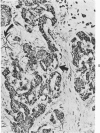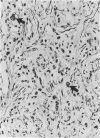Abstract
A combined morphometric, ultrastructural, and biochemical study was done on carotid bodies (CBs) obtained at autopsy from 213 patients in a pediatric and young adult population. The objective was to determine whether this group had statistically significant differences in sudden infant death syndrome (SIDS, n = 38), cystic fibrosis (CF, n = 30) and cyanotic heart disease (CHD, n = 17), compared with an age-matched control population (n = 128). Average combined weights of CBs in CF and CHD were significantly greater than those of controls in most age intervals (Student t test, P less than 0.05), and computerized planimetry showed an increase in both total surface area and area of "functional" parenchyma. There was diminished chief cell argyrophilia in 72% of CF CBs, and in 8 cases studied ultrastructurally there was moderate to marked depletion of dense-core neurosecretory granules. Most CBs from patients with CHD showed intense cytoplasmic argyrophilia similar to that of controls. Quantitative analysis for tissue catecholamines showed that dopamine was present in greatest concentration in each group of patients but was significantly elevated in CHD. There were no significant differences in morphometry, ultrastructure, or catecholamine content of CBs from SIDS victims, compared with age-related controls. These data add further support to CBs having a chemoreceptor role in humans with compensatory hypertrophy and hyperplasia occurring in most patients with chronic hypoxia due to CF and CHD. There were no significant findings to indicate that CBs play a direct role in the etiopathogenesis of SIDS.
Full text
PDF













Images in this article
Selected References
These references are in PubMed. This may not be the complete list of references from this article.
- Arias-Stella J., Bustos F. Chronic hypoxia and chemodectomas in bovines at high altitudes. Arch Pathol Lab Med. 1976 Dec;100(12):636–639. [PubMed] [Google Scholar]
- Arias-Stella J., Valcarcel J. Chief cell hyperplasia in the human carotid body at high altitudes; physiologic and pathologic significance. Hum Pathol. 1976 Jul;7(4):361–373. doi: 10.1016/s0046-8177(76)80052-4. [DOI] [PubMed] [Google Scholar]
- Berger A. J., Mitchell R. A., Severinghaus J. W. Regulation of respiration (first of three parts). N Engl J Med. 1977 Jul 14;297(2):92–97. doi: 10.1056/NEJM197707142970206. [DOI] [PubMed] [Google Scholar]
- Bockelman H. W., Arya S., Gilbert E. F. Cyanotic congenital heart disease with malignant paraganglioma. Cancer. 1982 Dec 1;50(11):2513–2517. doi: 10.1002/1097-0142(19821201)50:11<2513::aid-cncr2820501143>3.0.co;2-6. [DOI] [PubMed] [Google Scholar]
- Bradford M. M. A rapid and sensitive method for the quantitation of microgram quantities of protein utilizing the principle of protein-dye binding. Anal Biochem. 1976 May 7;72:248–254. doi: 10.1016/0003-2697(76)90527-3. [DOI] [PubMed] [Google Scholar]
- Chedid A., Jao W. Hereditary tumors of the carotid bodies and chronic obstructive pulmonary disease. Cancer. 1974 Jun;33(6):1635–1641. doi: 10.1002/1097-0142(197406)33:6<1635::aid-cncr2820330625>3.0.co;2-j. [DOI] [PubMed] [Google Scholar]
- Cole S., Lindenberg L. B., Galioto F. M., Jr, Howe P. E., DeGraff A. C., Jr, Davis J. M., Lubka R., Gross E. M. Ultrastructural abnormalities of the carotid body in sudden infant death syndrome. Pediatrics. 1979 Jan;63(1):13–17. [PubMed] [Google Scholar]
- Davidson J. T., Whipp B. J., Wasserman K., Koyal S. N., Lugliani R. Role of the carotid bodies in breath-holding. N Engl J Med. 1974 Apr 11;290(15):819–822. doi: 10.1056/NEJM197404112901502. [DOI] [PubMed] [Google Scholar]
- Edwards C., Heath D., Harris P., Castillo Y., Krüger H., Arias-Stella J. The carotid body in animals at high altitude. J Pathol. 1971 Aug;104(4):231–238. doi: 10.1002/path.1711040404. [DOI] [PubMed] [Google Scholar]
- Eriksson B. M., Persson B. A. Determination of catecholamines in rat heart tissue and plasma samples by liquid chromatography with electrochemical detection. J Chromatogr. 1982 Mar 12;228:143–154. doi: 10.1016/s0378-4347(00)80427-2. [DOI] [PubMed] [Google Scholar]
- Grimley P. M., Glenner G. G. Ultrastructure of the human carotid body. A perspective on the mode of chemoreception. Circulation. 1968 Apr;37(4):648–665. doi: 10.1161/01.cir.37.4.648. [DOI] [PubMed] [Google Scholar]
- Heath D., Edwards C., Harris P. Post-mortem size and structure of the human carotid body. Thorax. 1970 Mar;25(2):129–140. doi: 10.1136/thx.25.2.129. [DOI] [PMC free article] [PubMed] [Google Scholar]
- Heath D., Smith P., Jago R. Hyperplasia of the carotid body. J Pathol. 1982 Oct;138(2):115–127. doi: 10.1002/path.1711380203. [DOI] [PubMed] [Google Scholar]
- Kinney H. C., Burger P. C., Harrell F. E., Jr, Hudson R. P., Jr 'Reactive gliosis' in the medulla oblongata of victims of the sudden infant death syndrome. Pediatrics. 1983 Aug;72(2):181–187. [PubMed] [Google Scholar]
- Lack E. E. Carotid body hypertrophy in patients with cystic fibrosis and cyanotic congenital heart disease. Hum Pathol. 1977 Jan;8(1):39–51. doi: 10.1016/s0046-8177(77)80064-6. [DOI] [PubMed] [Google Scholar]
- Lack E. E. Hyperplasia of vagal and carotid body paraganglia in patients with chronic hypoxemia. Am J Pathol. 1978 Jun;91(3):497–516. [PMC free article] [PubMed] [Google Scholar]
- Lugliani R., Whipp B. J., Seard C., Wasserman K. Effect of bilateral carotid-body resection on ventilatory control at rest and during exercise in man. N Engl J Med. 1971 Nov;285(20):1105–1111. doi: 10.1056/NEJM197111112852002. [DOI] [PubMed] [Google Scholar]
- McDonald D. M. Regulation of chemoreceptor sensitivity in the carotid body: the role of presynaptic sensory nerves. Fed Proc. 1980 Jul;39(9):2627–2635. [PubMed] [Google Scholar]
- Mills E., Slotkin T. A. Catecholamine content of the carotid body in cats ventilated with 8 - 40% oxygen. Life Sci. 1975 May 15;16(10):1555–1561. doi: 10.1016/0024-3205(75)90073-9. [DOI] [PubMed] [Google Scholar]
- Naeye R. L. Brain-stem and adrenal abnormalities in the sudden-infant-death syndrome. Am J Clin Pathol. 1976 Sep;66(3):526–530. doi: 10.1093/ajcp/66.3.526. [DOI] [PubMed] [Google Scholar]
- Naeye R. L., Fisher R., Ryser M., Whalen P. Carotid body in the sudden infant death syndrome. Science. 1976 Feb 13;191(4227):567–569. doi: 10.1126/science.1251191. [DOI] [PubMed] [Google Scholar]
- Naeye R. L. Pulmonary arterial abnormalities in the sudden-infant-death syndrome. N Engl J Med. 1973 Nov 29;289(22):1167–1170. doi: 10.1056/NEJM197311292892204. [DOI] [PubMed] [Google Scholar]
- Naeye R. L. The sudden infant death syndrome: a review of recent advances. Arch Pathol Lab Med. 1977 Apr;101(4):165–167. [PubMed] [Google Scholar]
- Perrin D. G., Cutz E., Becker L. E., Bryan A. C., Madapallimatum A., Sole M. J. Sudden infant death syndrome: increased carotid-body dopamine and noradrenaline content. Lancet. 1984 Sep 8;2(8402):535–537. doi: 10.1016/s0140-6736(84)90763-3. [DOI] [PubMed] [Google Scholar]
- Perrin D. G., Cutz E., Becker L. E., Bryan A. C. Ultrastructure of carotid bodies in sudden infant death syndrome. Pediatrics. 1984 May;73(5):646–651. [PubMed] [Google Scholar]
- Remmers J., Mithoefer J. C. The function of the carotid body. N Engl J Med. 1971 Nov;285(20):1143–1144. doi: 10.1056/NEJM197111112852010. [DOI] [PubMed] [Google Scholar]
- Saldana M. J., Salem L. E., Travezan R. High altitude hypoxia and chemodectomas. Hum Pathol. 1973 Jun;4(2):251–263. doi: 10.1016/s0046-8177(73)80012-7. [DOI] [PubMed] [Google Scholar]
- Smith P., Jago R., Heath D. Anatomical variation and quantitative histology of the normal and enlarged carotid body. J Pathol. 1982 Aug;137(4):287–304. doi: 10.1002/path.1711370404. [DOI] [PubMed] [Google Scholar]
- Steele R. H., Hinterberger H. Catecholamines and 5-hydroxytryptamine in the carotid body in vascular, respiratory, and other diseases. J Lab Clin Med. 1972 Jul;80(1):63–70. [PubMed] [Google Scholar]
- Wharton J., Polak J. M., Pearse A. G., McGregor G. P., Bryant M. G., Bloom S. R., Emson P. C., Bisgard G. E., Will J. A. Enkephalin-, VIP- and substance P-like immunoreactivity in the carotid body. Nature. 1980 Mar 20;284(5753):269–271. doi: 10.1038/284269a0. [DOI] [PubMed] [Google Scholar]
- Whipp B. J., Wasserman K. Carotid bodies and ventilatory control dynamics in man. Fed Proc. 1980 Jul;39(9):2668–2673. [PubMed] [Google Scholar]
- Williams A., Vawter G., Reid L. Increased muscularity of the pylmonary circulation in victims of sudden infant death syndrome. Pediatrics. 1979 Jan;63(1):18–23. [PubMed] [Google Scholar]












